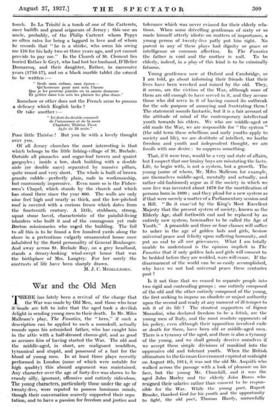Some Jersey Churches
WHILE a blue-bonneted Biscayan Frenchman was peddling onions through the streets of St. Heliers, a little mob of children followed hooting him in French (with delightful irony). for being a Frenchman. Though there is nothing a Jerseyman more detests than being called a Frenchman, and nothing upon which he prides himself more than the Battle of Jersey at which in.1781 twelve hundred invading French were beaten into surrender in the streets of St. Heliers by the Jersey Militia and some companies of a Highland- regiment, .yet French the Jerseyman is; and so is his language and so is his country. • In the fine old sturdy town-church of St. Heliers the morning service is always in French ; the potato-planting peasant of the outlying hamlets speaks (sometimes) nothing but the broadest of patois. But more than all, the whole atmosphere of the island, physical and moral, is French—a term which connotes a certain delicate neatness and indescribable charm. There are -the long- tailed -horses driven- with that abandon which only the French driver can practise without disaster._ There's the clean, pure air, the straight long-handled spade, the beautiful cows that are tethered at pasture—some.of them wear jackets in exposed situations, and of these, despite the wind-cutting hedges of Jersey cabbage, there are plenty ; and the curious, stiffly built, gaudily painted houses, so characteristic of parts• of France. We may have held these islands for a thousand years, but the flat British foot has left no trace on them. And the people are so sweetly polite. The peasant woman says to you, when you ask the way amid the baffling mazes of Jersey roads, " Go to the right, please " ; and polite- ness without servility meets one at every turning—and they are myriad. Indeed the people have the sweet, gentle manners of their beautiful cattle, and beauty, born of their manners, shines out in the faces of the women, for though they work as hard in the fields as the men, one hardly ever sees a coarse face and never meets with an uncivil word. • - -From France, too—from Brittany—came the first Christian missionaries to the Channel . Islands, St. Magloire, St. Maclou,_ and St. Sampson, son of an Armorican prince. They. came from a bleak and a barren land to islands that were once the same, and the stern- ness of their task, as also the strength of their faith, are typified. in the twelve Norman parish churches of Jersey, which stand strong, rugged and- austere, or, if- you prefer -it, squat, massive and plain. Probably the- first Breton missioners were not attractive persons, and the succeeding generation of their converts, when the early potato was not and when they could only draw a scanty and a dangerous harvest from the sea, best expressed their genius in architectural .austerity. Nor can it- be said that •the dark interiors, with their low-pitched aisles and short, trunk-like. Norman pillars, -offer much- to .delight the eye, . but here and, there. is a note of history and here and there a tender human touch. In La Trinite is a tomb of one of the Carterets, once bailiffs and grand seigneurs of-Jersey ; this one an uncle, -probably, of the Philip Carteret whom Pepys so .often rates for. being a laggard in love and of whom he records that " he is a shirke; who owns his owing me £10 for MS lady two or three years ago, and yet cannot provide to pay me." • In the Church of St. Clement lies buried Esther le Geyt, who had lost her husband, D'Helier Durnaresq, and their daughter, Esther, in successive years (1716-17), and on a black marble tablet she caused to be written :— " Soule sans onfans, sans epoux-
Qu'heureuse pour moi sera l'heure Que je les pourray joindre en to saints demeure Et gaiter dans ton sein les plaisirs les plus doux."
- Somehow or other does not the French seem to possess a delicacy which English lacks ? Or take - another :— " Ici dort du double sommeil de l'innocence et de la mort Charlotte Therese Picot Agee de 26 mois."
Poor little Therese. ! But you lie with a lovely thought over you.
Of all Jersey churches the most interesting is that which belongs to the little fishing-village of St. Brelade. Outside all pinnacles and sugar-loaf towers and quaint gargoyles ; inside a low, dark building with a double aisle (or double nave) separated by massive pillars, quite round and very short. The whole is built of brown granite rubble—perfectly plain, rude in workmanship, but enormously impressive. Even more so is the Fisher- men's Chapel, which .stands by the church and which has stood there since the year 800. The walls are only nine feet high and nearly as thick, and the low-pitched roof is covered with a curious fresco which dates from the fourteenth century. A little, stubborn, strong, squat stone hovel, characteristic of the painful-living islanders Who built it and of the courageous yet rude Breton missionaries . who urged the building. The foil to all this is to be found a few hundred yards along the shore in a pretentious vulgarly ornamented house once inhabited by the florid personality of General Boulanger. And away across St. Brelade Bay, on a grey headland, stands a dreary-looking wind-swept house that was the birthplace of Mrs. Langtry. For her surely the contrasts of life have been sharply drawn.
M. J. C. MEIKLEJOHN.



































 Previous page
Previous page